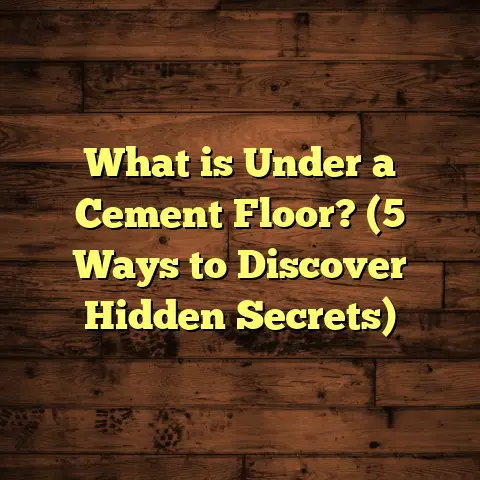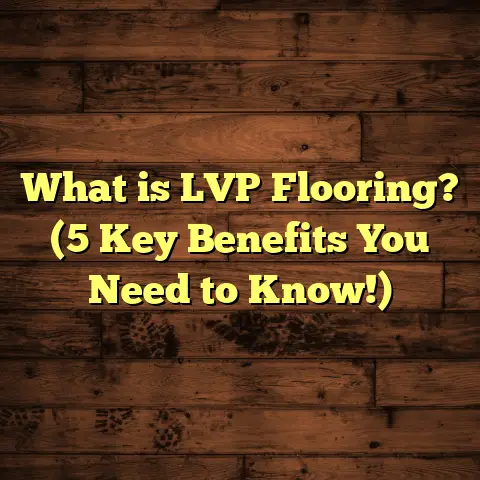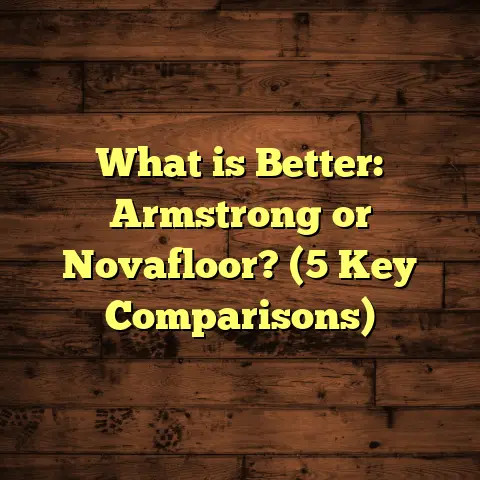What is Travertine Flooring? (5 Key Benefits to Know!)
Sustainability has become a huge factor for me when recommending materials for homes, especially flooring. I see it as a way to not just create beautiful spaces but also to make smarter choices that help the planet. Travertine flooring is one option I’ve worked with extensively, and it offers an interesting combination of natural beauty and eco-friendliness that few materials can match. After years of experience installing and maintaining travertine surfaces, I’ve gathered valuable insights that I’m eager to share with you.
What is Travertine Flooring?
Let’s start with the basics: what is travertine flooring? Travertine is a natural stone, a form of limestone that’s created by mineral deposits from hot springs or limestone caves. These deposits build up over thousands of years, forming dense layers of stone with a unique porous texture.
Its composition is mainly calcium carbonate, which is the same mineral that makes up marble and chalk, but travertine’s formation process gives it distinctive characteristics—particularly its pitted surface and warm earth-toned colors. Colors range from creamy whites and beiges to deep rusts and browns, making it versatile for many styles.
The stone is quarried in large blocks, then cut into tiles or slabs for flooring. What’s really interesting is those tiny holes or troughs you often see on travertine tiles. They’re part of the stone’s natural formation and can either be left open for texture or filled in for a smoother finish.
In my early days as a flooring contractor, I remember being fascinated by how this stone seemed to bring both ruggedness and elegance at once. One client wanted something that felt connected to nature but still refined enough for her modern home—the travertine fit perfectly.
The Formation and History of Travertine
Understanding where travertine comes from adds to its charm in my opinion. It forms near hot springs or limestone caves as water rich in calcium carbonate deposits layers of the mineral. Over time, these layers harden into stone.
The ancient Romans loved travertine so much they used it extensively in buildings like the Colosseum and Roman baths. This history isn’t just trivia—it’s proof of its durability. Structures built with travertine thousands of years ago still stand strong today.
This longevity has influenced many homeowners who want floors that will last decades without losing their appeal.
Why Choose Travertine Flooring? Five Key Benefits
I want to dive deeper into five major benefits that make travertine an excellent flooring choice.
1. Durability That Stands the Test of Time
One thing I always emphasize to clients is how durable travertine is. It ranks around 4-5 on the Mohs hardness scale (where 10 is diamond). This means it resists scratches better than softer stones like limestone or even some hardwoods.
I’ve had clients with busy households—kids running around, pets scratching floors—and travertine still looks fantastic years later. Unlike wood that can dent or warp with moisture changes, or vinyl that can peel, travertine holds up well under heavy use.
In one project for a family with three energetic kids, they had travertine installed in their main living area. After nearly 10 years, the floors showed only minor wear that was easily polished out during routine maintenance.
2. An Eco-Friendly Flooring Choice
Travertine is mined directly from the earth—meaning no chemical manufacturing processes like those involved with synthetic flooring materials such as vinyl or laminate. This reduces environmental impact significantly.
The extraction process can vary in environmental friendliness depending on quarry management practices, but many quarries now follow responsible harvesting methods to minimize damage.
Because travertine lasts so long—often over 50 years with proper care—it doesn’t need frequent replacement. This reduces waste generation and resource consumption over time.
In my experience working with eco-conscious clients, travertine often ranks high because it’s natural, recyclable (you can repurpose cut-offs), and requires fewer harsh chemicals for upkeep compared to some flooring types.
3. Unique Aesthetic Versatility
Travertine’s beauty lies in its natural variation. No two tiles are identical—the color tones and veining patterns vary from tile to tile, giving your floor a one-of-a-kind look.
You can find different finishes:
- Tumbled: Rounded edges and rougher texture for rustic appeal.
- Honed: Smooth matte finish for a modern look.
- Polished: Shiny surface that reflects light beautifully.
I’ve installed travertine in all kinds of settings—from classic Mediterranean-style homes to sleek contemporary spaces. It works equally well indoors and outdoors, adding warmth and character everywhere.
One memorable project involved using honed beige travertine tiles paired with dark wood cabinets in a kitchen. The contrast was stunning and gave the room a timeless yet fresh vibe.
4. Natural Cooling Properties
Stone floors like travertine have a thermal mass effect—they absorb heat during the day and release it slowly, which helps moderate indoor temperatures.
If you live somewhere hot (like much of the Southwest US), this natural cooling effect makes a big difference. I heard from clients in Arizona who noticed their homes felt cooler on hot days after installing travertine floors, even before turning on air conditioning.
The Department of Energy highlights stone floors as an energy-efficient flooring choice because they reduce reliance on mechanical cooling systems by keeping spaces cooler naturally.
5. Manageable Maintenance Routines
While some people think natural stone means difficult upkeep, travertine is more forgiving than you might imagine if you follow certain steps.
Sealing is critical because the stone’s pores can absorb liquids and stains otherwise. I always recommend sealing new installations within a week and resealing every year or two depending on foot traffic.
Daily cleaning involves sweeping or vacuuming loose dirt and mopping with mild pH-neutral cleaners (no acidic products like vinegar). This keeps the stone looking fresh without damaging its surface.
From my experience training homeowners on care routines, most find travertine maintenance straightforward once they get used to it. It helps that its natural texture hides minor imperfections better than polished stones.
How Travertine Compares With Other Flooring Types
I often get asked how travertine stacks up against other common floorings like hardwood, porcelain tile, or laminate. Here are some points from my hands-on experience:
| Flooring Type | Durability | Maintenance | Eco-Friendliness | Aesthetic Appeal | Cost Range (Material + Installation) |
|---|---|---|---|---|---|
| Travertine | High | Moderate | High | Natural & Unique | $10–$25 per sq ft |
| Hardwood | Moderate–High | Moderate–High | Moderate | Warm & Classic | $8–$15 per sq ft |
| Porcelain Tile | Very High | Low | Moderate | Versatile | $7–$20 per sq ft |
| Laminate | Low–Moderate | Low | Low | Imitates Wood/Stone | $3–$8 per sq ft |
| Vinyl | Low–Moderate | Very Low | Low | Wide Design Choices | $2–$7 per sq ft |
- Hardwood offers warmth but needs refinishing every few years.
- Porcelain tile is very durable but lacks the natural feel of stone.
- Laminate is budget-friendly but less durable and lacks authenticity.
- Vinyl is easy to maintain but less eco-friendly and less prestigious in appearance.
Travertine hits a sweet spot if you want natural beauty combined with long-lasting durability and don’t mind investing upfront.
Installation Insights From My Projects
Installing travertine isn’t as simple as laying down laminate or vinyl planks. It requires skill to handle the stone properly and ensure a lasting installation.
Here are some key points I’ve learned over years of installing travertine:
- Subfloor Preparation: The subfloor must be perfectly level and structurally sound because any unevenness can cause cracking.
- Cutting: Because travertine is dense but brittle, cutting requires specialized wet saws with diamond blades.
- Grouting: Using the right grout color enhances the look; lighter grout complements lighter stones while darker grout creates contrast.
- Sealing: Sealing should be done immediately after installation to protect against stains.
- Expansion Joints: Outdoor installations especially need expansion joints to allow for temperature changes without cracking.
One challenging but rewarding job involved installing tumbled-edge travertine outdoors in a garden patio prone to temperature swings. We incorporated proper expansion joints and used outdoor-rated sealants. The result? A stunning patio that remains intact after several winters.
Personal Stories: What Travertine Means To My Clients
I want to share some real-life stories from my work to give you a better feel for how travertine flooring impacts people’s lives:
Story 1: The Family Kitchen Makeover
A couple I worked with wanted to renovate their kitchen with something durable but warm enough for family gatherings. Their kids were young, so they needed floors that could handle spills and messes without constant worry.
We chose honed beige travertine tiles with filled pores for easy cleaning. The floors transformed their kitchen into a welcoming hub where everyone feels comfortable—even when things get messy during cooking marathons!
They told me months later how much they appreciated the stone’s natural look combined with its practicality. For them, it was perfect balance.
Story 2: Outdoor Pool Surround
Another client had a pool area that was slippery when wet due to smooth tiles previously installed. We replaced those with tumbled-edge travertine pavers which offered excellent slip resistance without sacrificing elegance.
Seeing kids running safely around the pool without slipping brought peace of mind to the family—something no amount of fancy pool furniture could replace.
How Much Does Travertine Flooring Cost?
Price matters a lot when planning any home project. Travertine isn’t the cheapest option out there but considering its benefits, many find it worth the investment.
Here’s a breakdown based on recent projects I’ve handled:
| Cost Factor | Price Range (USD) |
|---|---|
| Material | $5 – $15 per square foot |
| Installation | $5 – $10 per square foot |
| Sealing & Finishing | $1 – $3 per square foot |
| Additional Costs | Waste factor 5-10% |
The total usually ranges between $11 to $28 per square foot depending on quality and location.
Using tools like FloorTally helps me provide accurate estimates by factoring in local labor rates, material costs, waste allowances, and finishes preferred by clients. This transparency avoids surprises during budgeting.
Care Tips: Keeping Your Travertine Beautiful for Decades
Proper care extends your floor’s life significantly. Here’s what I recommend based on personal experience:
Daily Cleaning
- Sweep or vacuum regularly to remove grit that can scratch the surface.
- Mop with water and pH-neutral cleaner designed for stone.
- Avoid acidic cleaners (vinegar, lemon juice) or abrasive scrubbers as they etch stone surfaces.
Stain Prevention
- Wipe spills immediately—especially oil, wine, coffee.
- Use coasters under plants or decorative items to avoid moisture rings.
Sealing Routine
- Seal new floors within 7 days of installation.
- Reapply sealant every 12-24 months based on foot traffic.
- Outdoor floors may require more frequent sealing due to weather exposure.
Repairs
- Small chips can be filled with color-matched epoxy fillers.
- Polishing professionals can restore shine if floors dull over time.
A client once neglected sealing for several years which resulted in stubborn stains requiring professional restoration—a costly lesson that made them religious about resealing afterward!
Case Study: Renovating a Historic Home With Travertine Flooring
I had the privilege of working on restoring an early 20th-century home where original travertine tiles were part of the design heritage. The owners wanted to keep the historic feel but update surfaces safely for modern use.
We carefully removed damaged tiles for repair offsite while preserving as many originals as possible. New matching tiles were sourced from a quarry known for similar color tones.
It took months of careful work but resulted in floors that honored history while providing durability needed today.
This project showed me how travertine can connect past and present beautifully through thoughtful craftsmanship.
Final Thoughts: Is Travertine Right For You?
If you’re someone who values natural materials, durability, design flexibility, and sustainability, travertine flooring deserves serious attention. It combines old-world charm with modern performance in ways few materials do.
I’ve seen it create warm kitchens where kids play freely, elegant bathrooms that feel like retreats, and outdoor patios safe enough for all seasons—all while being kind to the environment compared to synthetic alternatives.
If you want help figuring out if your home suits travertine or need an estimate tailored to your space and budget using tools like FloorTally, just ask—I’m here to help make this decision easier.
Have you ever walked across travertine floors? What did you think? Or maybe you’re thinking about installing it now—what questions do you have? Let’s chat!





